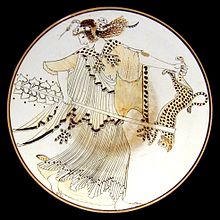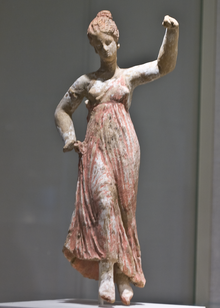Maenad

As maenads ( Ancient Greek Μαινάδες Mainades ) refers to both the mythical companions of the Dionysian trains and the historically verifiable cult followers. The image of the maenad and the maenadic cult were already strongly influenced in antiquity by the tragedy The Bacchae of Euripides .
designation
The term Mainades (from μανία manía "rage, madness") is first used by Homer in the second half of the 8th century. v. Used. In the course of time, regional differences in naming developed. This is how real followers of Dionysus , especially in Delphi , in historical times were called Thyiads ("the storming ones"), in Sparta Dionysiads . According to Pausanias , the name Thyade goes back to Thyia , who was the first priestess of Dionysus in Delphi. All other women in the region who went into a frenzy in honor of Dionysus are said to have been named after her.
In art and mythology the maenads are companions of Dionysus. They are wrapped in deer or leopard skin, especially in later depictions, and wear bandages, hoods, cymbals, flutes and the thyrsos in their hands .
The name Bacchantes , derived from the Greek name Bakchai (German: Bakchen ), is more common today. Bakchai are those who follow Bakchos and Bakchos is the Thracian name of Dionysus, who came from Thrace (compare also the Roman god Bacchus ). The Roman poet Catullus also calls the female followers of Cybele , the mother of gods of Asia Minor, maenads. Finally, the maenads in Thrace itself, especially the teachers of Dionysus child also be Bassariden called (of bassaros , " Red Fox "), according to them also supported fox skins.
In Macedonia , they were originally referred to as clodons ( Κλώδωνες Klṓdōnes ). After but during the reign of the Macedonian king Argaios an army of Illyrian Taulantians under Galauros had beaten by their wildness to flight - the Illyrians had the Thyrsoi swinging and masked with foliage women well for a squad berserker-like held Warriors - possessed Argaios, that a temple would be built to Dionysus Pseudanor , ie the "deceptive Dionysus", and that the Clodons should henceforth be called Mimallons ( Μιμμαλόνες Mimmalónes , roughly: "Imitators").
The term maenadism has been used since Eric Robertson Dodds (1951) and Henri Jeanmaire (1951) as a generic term for the entire cult complex of the female followers of Dionysus .
literature
- Judith Behnk: Dionysus and His Followers: Cults of Female Possession in Ancient Greece. Hamburg 2009. ISBN 978-3-8366-7929-9
- Jan N. Bremmer : Greek Maenadism reconsidered. In: Journal of Papyrology and Epigraphy . 55, 1984, pp. 267-286.
- Lin Foxhall : Women's ritual and men's work in ancient Athens. In: Women in Antiquity. New assessments. Routledge, London & New York 1995, pp. 97-110.
- Albert Henrichs : Greek Maenadism from Olympias to Messalina. In: Harvard Studies in Classical Philology. 82, 1978, pp. 121-160.
- Henri Jeanmaire : Dionysus. Histoire du culte de Bacchus. Paris 1951.
- Ingrid Krauskopf , Erika Simon , Barbara Simon: Mainades . In: Lexicon Iconographicum Mythologiae Classicae (LIMC). Volume VIII, Zurich / Munich 1997, pp. 780-803.
- Adolf Rapp : The maenad in the Greek cult, in art and poetry. In: Rheinisches Museum für Philologie . 27, 1872, pp. 1-22 and 562-611.
- Adolf Rapp: Mainaden . In: Wilhelm Heinrich Roscher (Hrsg.): Detailed lexicon of Greek and Roman mythology . Volume 2.2, Leipzig 1897, Col. 2243-2283 ( digitized version ).
- Lambert Schneider , Martina Seifert : Sphinx, Amazon, Maenad. Menacing images of women in ancient myth . Theiss, Stuttgart 2010, ISBN 978-3-8062-2226-5 .

